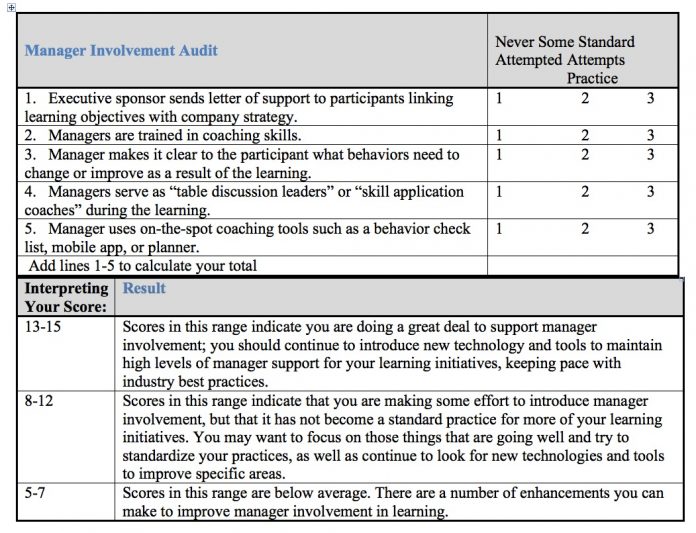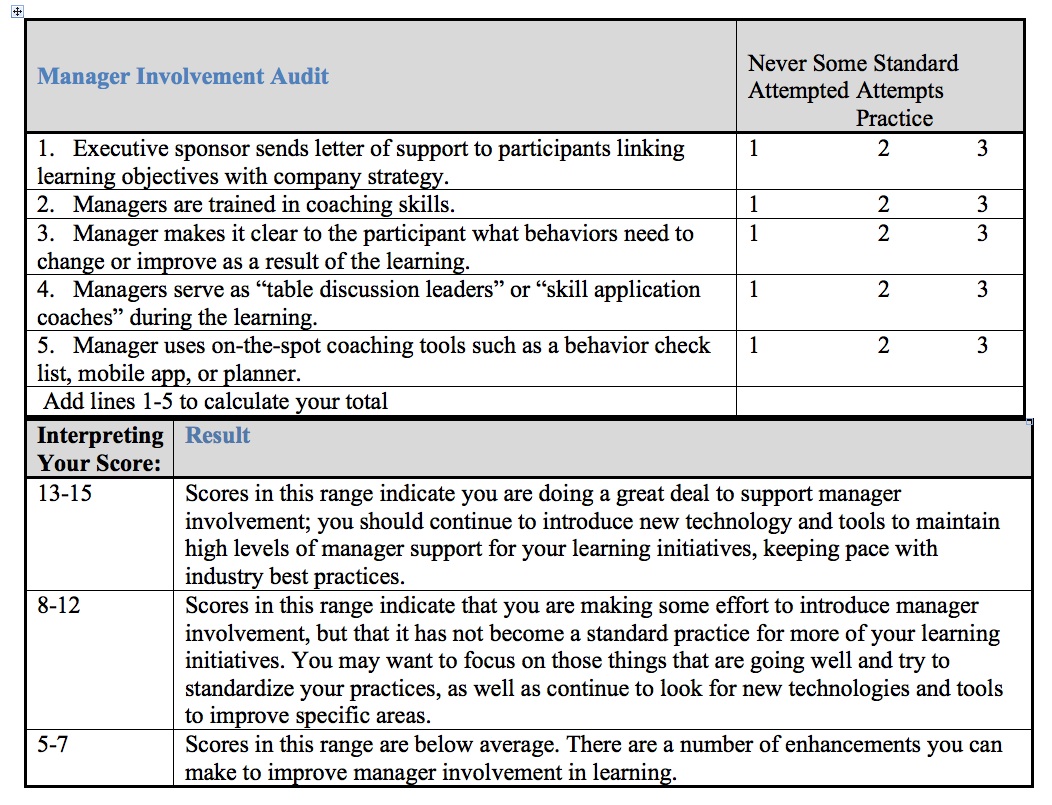
Conventional wisdom and practical application support the notion that “no job is too big with the right tool.”
From our numerous in-depth conversations and best practice sessions with CLOs and Training and Development directors over the last few decades, we are convinced that “giving managers coaching skills, along with the right tools at the right time, will yield the greatest learning impact.”
This collective wisdom holds some powerful implications for organizations wanting to pull learning from a learning event into positive, productive, supported learner application in the workplace.
Regardless of the training’s focus, equipping participants’ managers with a structured, methodical approach for learning coaching skills—something as straightforward as an easy-to-remember coaching process—greatly increases the likelihood of managers providing coaching that recognizes, reinforces, and/or redirects desired behaviors.
Our research shows an average performance improvement of direct reports of 18 percent after training mangers in coaching skills. Not bad. However, when you compare that to studies in which you train managers in both general coaching skills and in how to coach to the specific skills their employees are learning, you get a different picture. Performance improves 42 percent—or two-and-a-half times more than with coaching skills alone. This brings us to our next point.
Enlighten Managers with Knowledge of What Learners Are Learning
A great example of a highly effective coach is James (Doc.) Counsilman, who has the best win record of any college swim coach in history. Yes, he had great coaching skills, but what set him apart was his knowledge of swimming; he studied, researched, and wrote about swimming.
While not every coach needs the depth of a Doc. Counsilman, every effective coach needs to understand the skills he or she is coaching to. Unfortunately, in today’s fast-paced and busy work world, we often act as if a “quick overview” of the skills is enough to prepare managers to coach effectively.
Of course, the best-case scenario is providing the opportunity for managers to participate in the learning experience along with their direct reports. That being said, if time, place, or practicality doesn’t allow for managers to complete the very same training, there are several other ways to enlighten and involve busy managers.
- Consider the spectrum of engaging options for involving mangers:
- Concise e-learning modules delivered to managers’ desktops, taken when and where they are able.
- Embedding the training content into the coaching skills development program.
- A hands-on role at a learning workshop in which managers act as “table discussion leaders” during skill practice and application exercises.
- A front-of-the room role at a learning session in which managers act as co-facilitators and assist the professional facilitator, especially in the area of guiding and debriefing application exercises.
- At a minimum, managers should experience a thorough program overview delivered face-to-face, via Webcast, conference call, or video.
Enable Managers with Accessible, Timely Coaching Tips and Tools
The No. 1 reason managers give for not coaching more is “I don’t have the time!” Being ever-mindful of the time crunch faced by overloaded managers, as well as providing tips and tools that solve these time crunches, can boost the amount and the effectiveness of their coaching.
Best practices we have learned from organizations to address time issues include:
- Provide managers with “coaching sessions in a box” playbooks that include everything from e-mail invitations to scripts, key coaching questions, and worksheets. This way, managers do not have to create the coaching activity; they just have to deliver it.
- Focus managers on frequent, short coaching conversations rather than long coaching sessions. It is easier for a manager to find time to coach six employees for 10 minutes each rather than find time for a 60-minute coaching session.
- Push out weekly reminders to coach—make coaching not something they do, but who they are.
- Provide video models of short coaching conversations; a major reason that holds managers back from coaching is the fear that they will do it incorrectly. Modeling videos help overcome that fear.
- Consider the message and the media. Send the right message at the right time. Keep content chunks small, digestible, and actionable. Provide easy access to planners, behavior checklists, mobile apps, and other tools.
Assessing Managerial Involvement
So, are your managers prepared for this critical role?
We have captured a handful of the most important actions organizations need to take to leverage managerial involvement and organized them into a Manager Involvement Audit. This provides for quick assessment of your managers’ readiness to support learning.

Never Attempted? Some Attempts? Standard Practice?
Did this quick pulse check reveal a vital, robust learning transfer approach that fully leverages manager involvement in your organization? If so, bravo! If the job seems too big, consider the three practices we described and begin the process of increasing manager coaching, increasing learning transfer, and maximizing the ROI of your training efforts by effectively involving managers in learning. After all, no job is too big with the right tools.
If you would like to take the complete Manager Involvement Audit and put some qunaitifable numbers around your assessment, contact us to receive a complimenary copy, along with the interpretation of what your score indicates from the Manager Involvement Scorecard. Contact Wilson Learning at 800.328.7937 or visit www.wilsonlearning.com.
Michael Leimbach, Ph.D., is vice president of Global Research and Development for Wilson Learning Worldwide. With more than 25 years in the field, Dr. Leimbach provides leadership for researching and designing Wilson Learning’s diagnostic, learning, and performance improvement capabilities. Dr. Leimbach has managed major research studies in sales, leadership, and organizational effectiveness, and has developed Wilson Learning’s impact evaluation capability and return on investment models. Dr. Leimbach has served as a research consultant for a variety of global client organizations, is on the editorial board for the ADHR professional journal, and serves in a leadership role for ISO technical committee TC232: Standards for Learning Service Providers. Dr. Leimbach has co-authored five books, has published numerous professional articles, and is a frequent speaker at national and global conferences.
Carl Eidson, Ph.D., is vice president of Business Development for Wilson Learning Corporation. Dr. Eidson leads and coaches a virtual team of more than 100 independent distributors stretching from Toronto to Bogotá. To influence and impact results remotely, he leverages innovative communication technologies and virtual leadership skills to create systems for salesforce development, marketing campaigns, and client-centered promotional events. With a doctorate in industrial and organizational psychology, he has co-authored articles on selecting top talent published in scholarly journals, including Journal of Applied Psychology, Human Performance, International Journal of Selection and Assessment, and Journal of Business and Psychology. Dr. Eidson is a frequent speaker at professional conferences on the topic of human performance improvement research and practices. For more information, visit www.WilsonLearning.com or call 800.328.7937.




